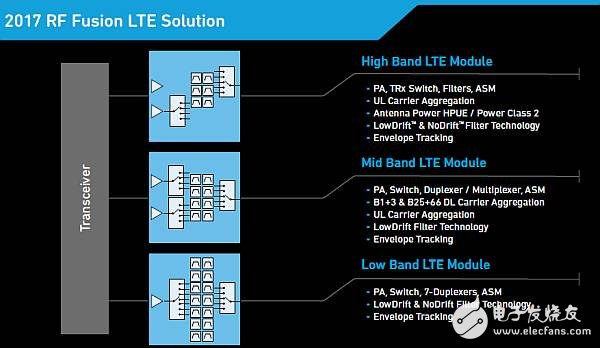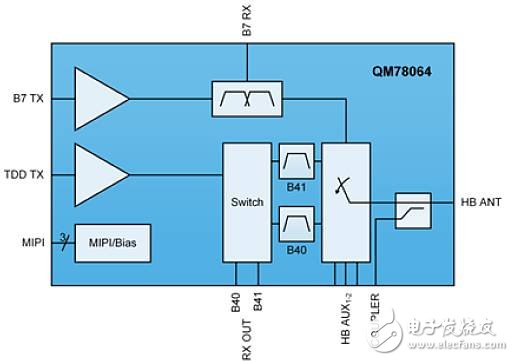As the complexity of the RF front end (RFFE) continues to increase, the insertion loss and link budget will increase. In addition, HPUE/2 power requirements can increase design complexity. Here's what designers need to know to design a reliable RF front end for upcoming mobile devices.
To understand other aspects of the puzzle, I asked Ben Thomas, Director of Technical Marketing at Qorvo, and asked him what he thought about the radio frequency (RF) solution for receiving and transmitting mobile phones. What can we expect to filter out the growing frequency bands and the multiple antennas added to the phone? How can the next generation of smartphones achieve the required gigabit speed?
According to Thomas, Qorvo believes that with the advent of the 5G era, there will be a fundamental shift in the way mobile data is used worldwide. For a whole new generation of technology, streaming video is a new benchmark for entertainment and information.
Here are some real-time issues that affect smartphone manufacturers today. Qorvo is addressing several key challenges to help mobile phone OEMs address RF complexity:
Meet fast-changing standards, including carrier aggregation and MIMO
? Balance size and performance
Carrier aggregation combination through filters and multiplexers
• RFFE alternative solutions for high-end and mid-range smartphones
Qorvo currently has a 2017 RF Fusion solution consisting of multiple modules.
Global carrier aggregation (CA) band coverage is available for industry flagship smartphones and is small (Figure 1).

Figure 1 2017 RF Fusion LTE Solution (Image courtesy of Qorvo)
Of course, their roadmap has been extended to 2018, when many early 5G architectures will be shown at the PyeongChang Olympics (Figure 2).

Figure 2 RF Fusion circuit diagram extended to 2018 (Image courtesy of Qorvo)
The challenge is that the smartphone sector has some design goals and different priorities . Two important categories include flagship phones designed for super zone/global use, as well as mid-range and entry-level phones designed for regional use.
RFFE is highly integrated in Super Zone/Global Capabilities phones. Multiple frequency bands and combinations of uplink and downlink carrier aggregation are required to accommodate different performance needs. Because of the compact size of the phone and its slim size, it takes extra space to fit into the battery and multiple antennas, creating additional challenges. Qorvo offers an RF Fusion solution for this type of handset that integrates all required transmit/receive features, including major frequency bands. The solution includes three modular solutions for full coverage of the high, medium and low frequency spectrum regions. Each module integrates a power amplifier (PA), switches and filters. Figure 3 shows an example of a high-band block diagram. Samsung Galaxy S7 electronic product dismantling diagram, internal QM78064, including bill of materials (BOM).

Figure 3 Qorvo's RF Fusion QM78064 high-band module, which supports both FDD-LTE (with integrated band 7 duplexer) and TDD-LTE (bands 40 and 41) with a support for 20 MHz + 20 MHz upstream carrier aggregation Broadband B41 Lowdrift Bulk Acoustic Wave (BAW) filter. In addition, there is an antenna switch that supports Envelope Tracking (ET) and Average Power Tracking (APT) to increase the efficiency of the transmit power amplifier, thereby improving power efficiency and helping to extend battery life. (Image courtesy of Qorvo)
Eliminate redundant onboard matching to reduce losses
Another area where loss reduction can be achieved is the elimination of redundant onboard matching used on most traditional design architectures. The Power Amplifier and Integrated Duplexer (PAMiD) architecture can “directly†match the filter while reducing the receive loss of the receive (RX) and transmit (TX) channels up to 0.5 dB (Figure 4).

Figure 4 The RF Fusion architecture eliminates redundant on-board termination and therefore improves TX and RX losses by up to 0.5 dB. (Image courtesy of Qorvo)
The bulk acoustically fixed resonator (BAW-SMR) filter technique is used in the mid to high frequency band (the most difficult to handle frequency band) because carrier aggregation is an optimized design technique in smartphones. For more information on RF filters, check out the RF Filter Technology Stupid Book.
Smartphones need more mobile data when moving toward a 1 Gb/s target. The challenges are severe, but the industry is ready for the challenge. Global operators continue to add more of the allocated spectrum to the band, so smartphones need to be able to handle these new bands. Many of these bands are combined to support multi-carrier operation, allowing smartphones to operate on multiple carrier frequencies simultaneously.
In addition, MIMO enables new mobile phones to achieve simultaneous data streams, which significantly increases the complexity of RF. This complexity will only increase, and adding higher order modulation will only increase the difficulty of RF design.
According to Ben Thomas, Qorvo can even adopt innovative technologies in its Infrastructure and Defense Products (IDP) business, including solid-state designs and related power amplifiers in millimeter-wave technology, as well as defense low-noise amplifiers (LNAs).
The next phase of development will be integrated into Europe, China, Japan and Korea. To achieve this goal, in late January 2017, Qorvo became the first RF supplier to join China Mobile's 5G Chuanglian Center.
They are also introducing four 28 GHz RF solutions for 5G base stations using GaN-on-SiC and GaA processes. These products include a phase shifter, two transmit amplifiers, and a power amplifier. Recently, they launched their first 39 GHz dual-channel GaN front-end module in June 2017.
With the approach of the 2018 Olympics and the 2020 Tokyo Olympics, an exciting time for RF electronics is coming, which will be the turning point for 5G to move to full compliance with the proposed standards.
Author: Steve Taranovich is a senior technical editor of EDN, has 45 years of experience in the electronics industry.
Paperlike Screen Protector For IPad
Paperlike Screen Protector,iPad Paperlike Screen Protector,Paperlike Screen Protector iPad
Shenzhen Jianjiantong Technology Co., Ltd. , https://www.jjtbackskin.com
